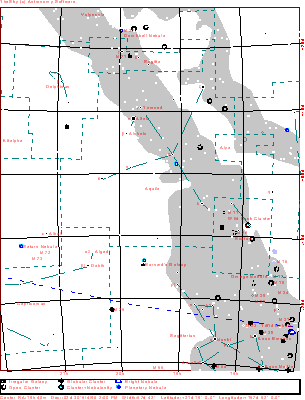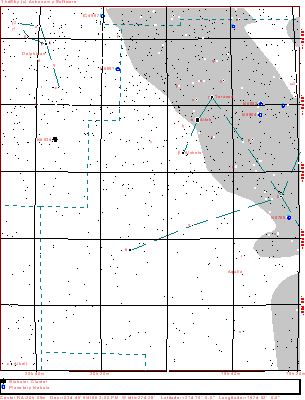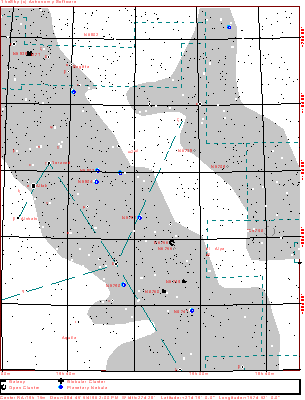
| Home | Deepsky Atlas | TheAstronews | Links | Solar System | ||||||

Hawaiian Astronomical SocietyConstellations: Aquila -- Doing his Master's Bidding |
||||||||||
Ganymede was the son of king Tros (or Laomedon) of Troy, a city located in northwestern Asia Minor. The major moons of Jupiter were all named after Zeus' lovers, and Ganymede, though he was a boy, was no exception.
Zeus' daughter Hebe (the goddess of youth) was the cupbearer to the gods, but she had to be relieved from duty when she married Heracles (Hercules). Zeus then spied the beautiful boy Ganymede, and fell in love with him. Zeus wanted him as his lover, and the new cupbearer.
Here the story diverges. One version tells of Zeus disguised as an eagle, and carrying Ganymede to Mt. Olympus (located in Macedonia). Another version speaks of Zeus' armor bearer, an eagle who had assisted Zeus in his battles with the Titans. This eagle, always willing to help, flew down, grabbed the boy, and carried him to Zeus. Zeus gave Tros a stud of immortal horses as compensation.
One final note: One way to spell Ganymede is Catamitus, from which we derive the term, "catamite," or prepubescent, male, sex partner to an older male (who is, in turn, called a pederast).

Click the map for a 916x1200 version of the above. Click here for a map better suited for use in the field.

This a more detailed view of the constellation. The map displays stars to magnitude 10, and deepsky objects to magnitude 12. Click here for a map better suited for use in the field.

Click here for a map better suited for use in the field.

Click here for a map better suited for use in the field.
 23k JPEG NGC6781 (Best 3) is a planetary nebula located 3.8° NNW of Delta Aquilae, the constellation's most central star. Dreyer describes it as faint (mag. 11.8), large (1.8'), and round, with very abruptly brighter middle disc. A faint star lies northeast. Observers note that the "brighter middle" is not that visible on smaller instruments. It is also offset to the south. As with most planetaries, this one responds well to "nebula" filters. 23k JPEG NGC6781 (Best 3) is a planetary nebula located 3.8° NNW of Delta Aquilae, the constellation's most central star. Dreyer describes it as faint (mag. 11.8), large (1.8'), and round, with very abruptly brighter middle disc. A faint star lies northeast. Observers note that the "brighter middle" is not that visible on smaller instruments. It is also offset to the south. As with most planetaries, this one responds well to "nebula" filters.
Image by Jack Newton, taken with a 16" SCT, and posted on Doug Clapp's web site.
|
 40k JPEG NGC6709 is an open cluster located in a rich section of Milky Way. Described as fairly rich, it contains about 40 stars mag. 9 and fainter. Total magnitude is 6.7, it covers 13' of sky, and sits 4.7° south-west of Zeta Aquilae. From the Digital Sky Survey. 40k JPEG NGC6709 is an open cluster located in a rich section of Milky Way. Described as fairly rich, it contains about 40 stars mag. 9 and fainter. Total magnitude is 6.7, it covers 13' of sky, and sits 4.7° south-west of Zeta Aquilae. From the Digital Sky Survey.
|
 94k JPEG Barnard 143 is a dark nebula located 1.5° WNW of Tarazed (Gamma Aquilae). From dark skies, this is a good binocular object covering an irregular (40') area of sky. A telescope that shows a degree of sky will also show it well. From the Digital Sky Survey. 94k JPEG Barnard 143 is a dark nebula located 1.5° WNW of Tarazed (Gamma Aquilae). From dark skies, this is a good binocular object covering an irregular (40') area of sky. A telescope that shows a degree of sky will also show it well. From the Digital Sky Survey.
|
If you have any questions about the Hawaiian Astronomical Society
please
(link requires javascript).